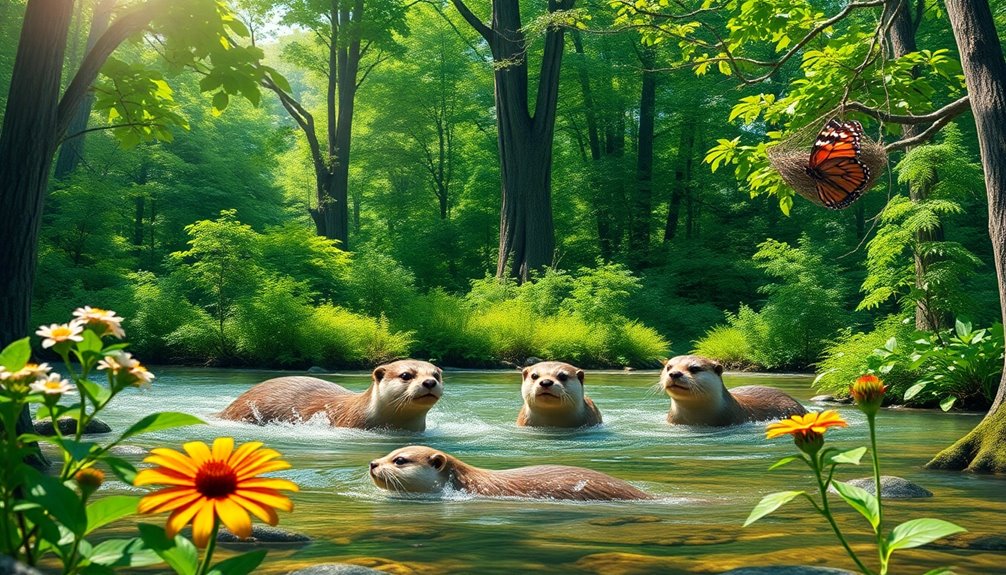Conservation efforts have led to remarkable species rebounds, proving that nature can thrive even in the face of biodiversity decline. For example, the Iberian lynx population soared from 62 individuals to over 2,000, and humpback whales recovered after the commercial whaling ban. Such successes highlight the importance of effective legislation and community engagement in restoring wildlife. These stories demonstrate that with dedicated action, we can protect our planet's rich biodiversity. There's much more to discover about these inspiring initiatives.
Key Takeaways
- Successful conservation efforts have led to notable species recoveries, such as the Iberian lynx and kākāpō, despite ongoing biodiversity challenges.
- Legislative actions, like the Endangered Species Act, have played a crucial role in protecting species from extinction and facilitating population rebounds.
- Community engagement and collaborative strategies enhance the impact of conservation programs, enabling species to recover even amid habitat destruction and pollution.
- Economic benefits from biodiversity highlight its importance, as healthy ecosystems support critical services for human well-being and resilience against environmental changes.
- Continued focus on science-based methods and dedicated initiatives is essential for sustaining species recovery and addressing the broader biodiversity decline.

As our planet faces increasing environmental challenges, the remarkable success stories of conservation efforts remind us that we can still reverse the decline of endangered species.
Take the Iberian lynx, for instance. Through dedicated initiatives, its population has surged from a mere 62 mature individuals in 2001 to over 2,000 today. This incredible recovery showcases how focused conservation can yield positive results, particularly as the Iberian lynx has improved from Endangered to Vulnerable on the IUCN Red List. Additionally, the use of solar energy solutions in conservation areas can support sustainable practices that benefit wildlife habitats.
Similarly, the Kākāpō, a flightless parrot, has seen a rebound thanks to concerted recovery programs. These efforts highlight the importance of targeted actions in restoring species.
In the United States, the Endangered Species Act has been instrumental, helping 99% of listed species avoid extinction over its 50-year history, proving that effective legislation can make a significant difference.
The impact of human actions on wildlife isn't always detrimental. For example, the ban on commercial whaling has led to a significant recovery of humpback whales, now classified as least concern by the IUCN.
The ban on commercial whaling has allowed humpback whales to thrive, now classified as least concern by the IUCN.
These stories emphasize that, while threats like habitat destruction and pollution persist, there's hope through concerted efforts.
Another impressive success story is that of the European bison. Once extinct in the wild, conservation strategies have enabled its return to parts of Eastern Europe, demonstrating the power of collaborative approaches in conservation.
Protecting these species is crucial for maintaining ecosystem balance, as their decline often signals broader environmental issues.
Biodiversity is essential, not just for the planet but also for human well-being. Over half of global GDP relies on nature, underscoring the economic importance of protecting endangered species.
Effective conservation strategies, including community engagement and science-based methods, are vital for maximizing impact.
While challenges remain, these success stories remind us that with dedication, collaboration, and informed action, we can help restore and protect the incredible diversity of life on Earth.
There's always room for hope and progress in the fight for conservation.
Frequently Asked Questions
What Are the Main Causes of Biodiversity Decline?
Biodiversity decline mainly stems from habitat destruction, which you can see in deforestation, urbanization, and infrastructure development.
Overexploitation of resources, like overfishing and excessive hunting, further diminishes species populations.
Environmental factors, including climate change and pollution, disrupt ecosystems.
Additionally, human activities driven by population growth and economic pursuits exacerbate the problem.
It's crucial for you to understand these causes, as they impact the planet's health and sustainability for future generations.
How Do Conservation Efforts Impact Local Economies?
Conservation efforts significantly impact local economies by creating jobs in tourism and park management.
When you protect natural areas, you attract businesses and increase property values. More visitors lead to higher tax revenues, benefiting the community.
Additionally, nature-based tourism diversifies rural economies, providing income streams.
Can Individual Actions Really Help Species Rebound?
Think of a single drop of water creating ripples in a pond. Your individual actions can indeed help species rebound.
By reducing waste, supporting conservation initiatives, or even volunteering, you contribute to a larger movement. Every small effort counts; it adds up to significant change.
When you engage with your community and advocate for biodiversity, you amplify those ripples, encouraging collective action that can lead to real recovery for vulnerable species.
What Role Do Invasive Species Play in Biodiversity Loss?
Invasive species disrupt ecosystems by outcompeting native species for resources, leading to significant biodiversity loss.
When you introduce non-native plants or animals into an environment, they can alter habitats and food webs, pushing native species toward extinction.
You mightn't see the immediate effects, but over time, the balance of the ecosystem shifts, resulting in diminished species diversity.
Recognizing their impact is crucial for protecting the natural world you care about.
How Is Climate Change Affecting Conservation Strategies?
Climate change is reshaping conservation strategies in significant ways.
You'll notice that shifting species distributions challenge traditional static reserves, while increased extinction risks threaten isolated species.
As temperatures rise and precipitation patterns change, habitat loss and fragmentation worsen.
To adapt, you'll need to develop new strategies that incorporate climate projections into planning, ensuring conservation efforts remain effective in a rapidly changing environment.
Prioritizing adaptability is crucial for protecting biodiversity.
Conclusion
In the grand scheme of things, it's heartening to see species bouncing back thanks to dedicated conservation efforts. While biodiversity may be facing challenges, these success stories prove that with a little hard work and commitment, we can turn the tide. You've got the power to make a difference, whether it's supporting local initiatives or spreading awareness. So, let's roll up our sleeves and keep working together to ensure a thriving planet for generations to come!









